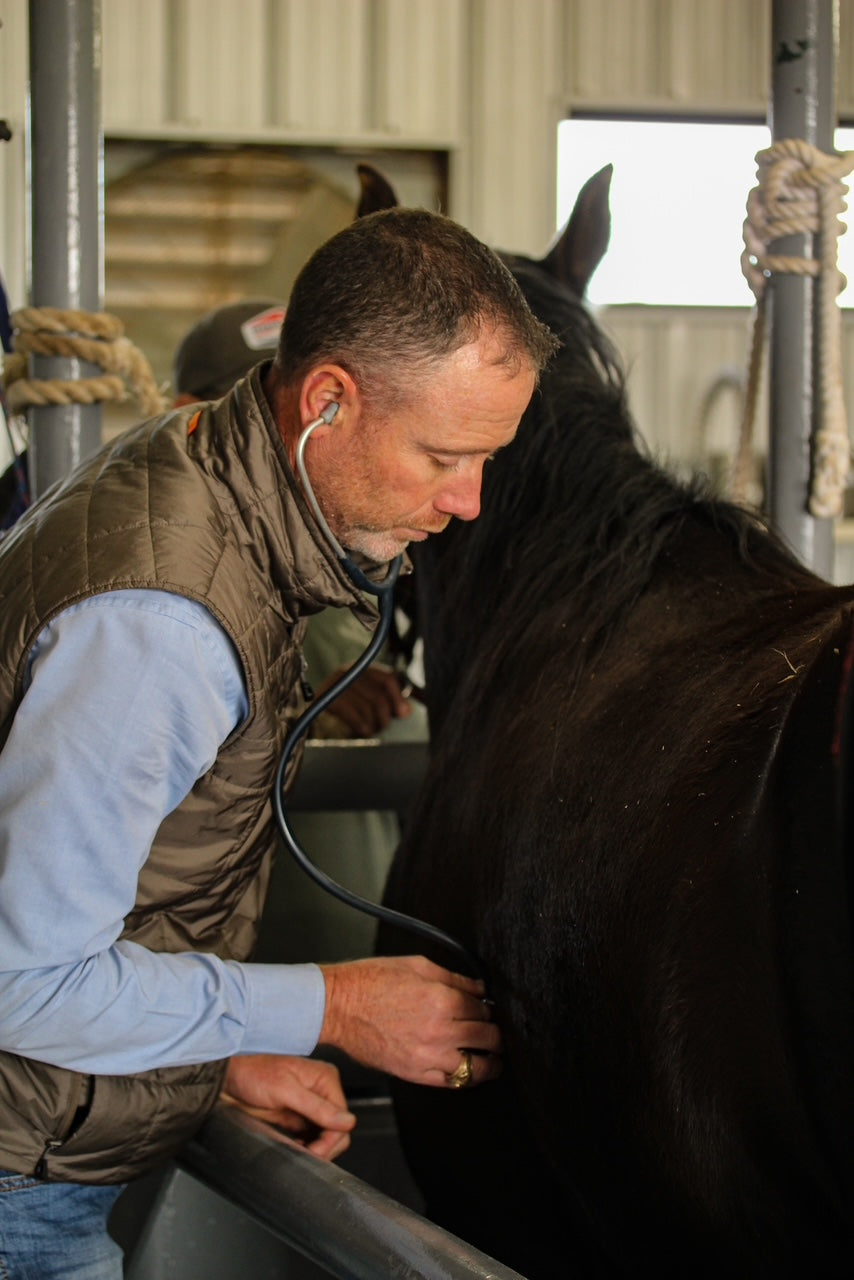2,000 Mares Later: What 1 Vet Wants You To Know
May 6, 2025

When a new baby enters the world—whether human or horse—most people naturally focus on the newborn. What are they like? How are they doing? Are we doing enough to protect them from harmful pathogens, given their undeveloped immune systems? The questions go on, and rightly so.
But there’s another half of the equation that often gets overlooked: the mother. In this blog, we sit down with FullBucket co-founder Dr. Rob Franklin, an equine veterinarian who has worked with nearly 2,000 mare-and-foal pairs over his 25-year career.
Here are his top mare care tips — no matter the season.
Q: Dr. Franklin, could we discuss the biggest challenges that broodmares face in 4 different stages of their year?
Pregnancy:
A: You bet. Early on, we do not see a lot of challenges. Early pregnancy is not a bumpy road because there are few metabolic demands and few lifestyle changes. As the pregnancy continues, challenges arrive in the last trimester.
That’s when there is a lot happening for mares. First, there is a much greater metabolic drive and their nutritional needs increase. Typically, this also coincides with winter. This means that mares need to enter winter in a good body condition, and then need to be maintained with an increasing level of nutrition.
In order to account for this big nutritional delta from being out on pasture in the summer and fall to providing hay and concentrated grains, we start to move mares around to pens and stalls. This change in management can create not only strain on the GI tract, but also some psychological stress.
When you add all of these changes together, it can create tipping points for mares with underlying conditions. In the industry, we inevitably have mares that are no longer able to perform athletically due to orthopedic injury, and when we breed them, they often cope with these conditions while the foal is small and they are out on pasture in the summer. In the later months of pregnancy, the aches and pains get accentuated from colder weather, inflammatory diets rich in grain, and decreased mobility due to inclement conditions, so this is a time when owners need to be worried about how the mare is doing.
Additionally, colic can be a derivative of these changes in condition. In late pregnancy, we see more mares colicking. Sometimes those colics can be severe, so we want to be on top of that quickly, because for something like a twisted colon, every minute counts.
Foaling:
The first and most obvious challenge surrounding foaling is dystocia, or a difficult birth. Everyone worries about this because you have spent so much time deciding who to breed the mare to, breeding the mare, going through the process of insemination, and then you wait 11 months for this foal to arrive, and then once the birth arrives, it all happens very quickly.
The mare is different from most other livestock in that they foal very quickly, typically within 15 minutes of the water breaking to the time that the foal is delivered. It is often shorter, but if it is longer than 15 minutes, you need to contact help because the foal may be positioned the wrong way. This could mean that a knee is bent back or the head is pointed the wrong way or it could be breach, but of course, any of these things can impede the ability for the mare to deliver the foal.
Assistance has to happen quickly in these cases, which is why so many breeding farms have night watchmen, who are very handy horse people, to patrol those mares. They act like midwives. They can fix simple problems, and they know when to call a veterinarian.
All of this to speak to the gravity of the foaling process. You have gone through so much with this mare and foal, and you do not want to wake up and come to the barn in the morning to discover a dystocia that resulted in death.
The other challenge during foaling is that the mare can experience foaling trauma, such a tear in the reproductive tract. This requires immediate veterinary attention as well.
Next, the mare needs to produce milk. Hopefully, before foaling, she made a good bag of colostrum that sealed up with wax to prevent leaking, because mares only make this colostrum one time.
And, finally, the mare has to pass her placenta. The theme with foaling is that everything happens fast. A good rule of thumb is the 1,2,3 Rule.
-
The foal should stand in 1 hour.
-
The foal should nurse within 2 hours.
-
The mare should have passed her placenta in its entirety by 3 hours.
It is very common for the placenta to hang on for a little bit after the foal is delivered. When a foal gets up to nurse, the mare’s brain naturally releases oxytocin, which helps with milk letdown as well as the expulsion of the placenta. We can also intervene with oxytocin, if needed, to promote contraction and help expel the placenta.
This is why number 1 and 2 of the Rule is getting the foal up and nursing; because this helps with number 3.
Remember, save the placenta until your veterinarian comes out because they will examine it during the mare and foal check.
To recap, watch for dystocia, make sure the mare did not experience any trauma, make sure that she makes milk, and that she passes the placenta within 3 hours.
Recommended Reading: Broodmare Preparation: 5-6 Days Out
Lactation:
The most common lactation issues that we see have to do with establishing a latch. In human medicine, there are lactation consultants that specialize in this, but not in the horse world. Especially with young or maiden mares, we need to watch and make sure that the foal has access to the milk. It seems trivial and we tend to think that nature will just take care of it, but that is not always the case.
Otherwise, lactation tends to go pretty smoothly, and the only thing that impedes it is poor nutrition, or if the mare gets sick, which causes them to not make enough milk for the foal. If the foal is always at the mare’s bag and always drinking, the mare may not be making very much milk.
Recommended Reading: Your Mare’s Gut Health Impacts Colostrum Quality
Weaning:
Weaning is a time of change, and horse people need to realize that any change is not without consequence to the horse.
During weaning, many of the changes that breeding season has inflicted on the mare begin to unravel. Once the mare is rebred and weaned, her whole operation changes again.
Their diet changes, their housing changes, their social structure changes. Any time there is environmental, nutritional, or psychological change, the horse is potentially at risk for something breaking, if you will. I don’t mean literally, but any chronic conditions that a mare has been dealing with can come on during these times.
In your experience, what nutrient requirements are often forgotten for broodmares?
You know, something we don’t talk about enough is how crucial pre- and probiotics really are for a mare. These are not optional supplements, in my opinion.
When you consider the husbandry changes, the nutritional changes, the metabolic demands, etc., we are really setting the mares up for failure. Often, that failure is colic.
Utilization of pre- and probiotics can optimize the gut to its top functioning level and help maximize digestion. If the gut is working well, and has healthy microbes to help digest fiber, your mare is going to get the maximum amount of nutrition out of their feed.
Not to mention that prebiotics and probiotics stimulate the immune system both locally and systemically. Mares, especially in late pregnancy, are in the process of accumulating their best passive immunity to pass on to their foal. The mare’s body queues up the production of antibodies for colostrum.
We have to remember that, in horses, antibodies do not cross the placenta, and the foal only has one chance of receiving those necessary antibodies. Research has shown that prebiotics and probiotics stimulate the immune system and can actually enhance colostrum quality.
Once the foal arrives, and mares begin lactation, their nutritional needs increase massively. They really need to squeeze every ounce of “juice” out of their feed, because there just isn’t much in reserve. The correct combination of prebiotics and probiotics can help mares get the maximum amount of energy out of what you provide them in their diet.
Recommended Reading: 3 Tips for Keeping Broodmares Healthy
What do you wish the industry understood about mares?
The thing that I spend a lot of time thinking about, is how common it is for us to take mares for granted.
When we're in the moment of breeding the mare, we are usually more worried about lining up the semen, wondering what the follicle is doing, and in the meantime, this is all happening in the mare, who is an individual, and needs to be cared for as such.
It’s common for them to be kicked out after their 45-day checks, and it becomes an “out of sight, out of mind” type of situation. It is easy to take for granted all that has to happen in such a short period of time during late pregnancy, delivery, and raising the foal.
If someone were to ask me what I learned in 25 years of veterinary practice working on mares and foals, the number one thing I would say is: Give the mare the consideration she deserves.
She has a big and a hard job, and there are a lot of changes that occur in that time period. I have seen too many train wrecks where people think it was a fluke or an act of God, when really it was due to neglect. I do NOT mean cruelty, but rather neglect in considering the mare.
For example, if a mare has had a compromised tendon on her right front for her entire life, and now she’s carrying a foal and weighs several more 100 pounds than she did before, this will impact that prior injury. As she moves through pregnancy into a stall where she is not moving around as much, it can be easy to miss that she is trying to get off that right front. She gets heavier and heavier, and if no one has noticed that she is now standing on her left front more to get off the right, she could founder on the left. People tend to react in surprise, but the signs were all there; she had multiple risk factors.
This is just one example, but I have seen this over and over with mares who have metabolic disease, past history of laminitis, chronic gut conditions, trouble maintaining weight, etc. If no one digs into it until it comes to a head, then it really turns into a serious problem.
I encourage everyone to really know their mares on an individual basis, know what she is up against, and get ahead of it. Don’t wait for something bad to happen and then start reacting.
In conclusion
Caring for the newborn foal is undeniably important, but so is caring for the mare who brought that foal into the world. As Dr. Franklin's experience shows, a healthy, well-supported mare is the foundation for a thriving foal.
Through monitoring nutrition, watching for signs of a problem, and making accommodations to minimize the negative impact of changes, these seemingly small acts of care go a long way. By shifting some of our focus back to the mare, we’re not just improving outcomes, we’re honoring the incredible role she plays in our industry.
Shop the FullBucket veterinarian-formulated pre- and probiotics for mares here!

